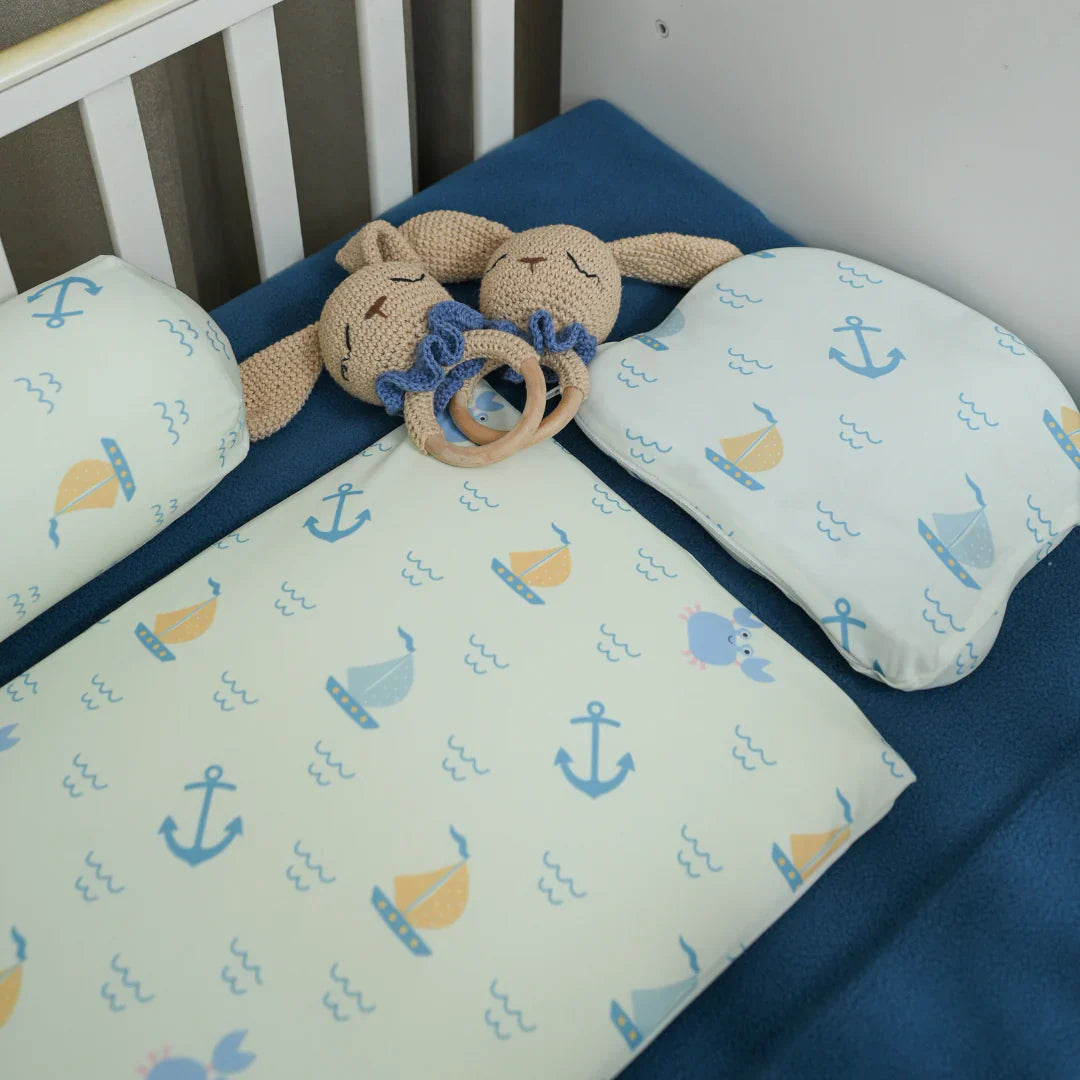There’s something magical about watching your little one sleep. The peaceful rise and fall of their tiny chest, the soft murmur of baby dreams—it’s a moment every parent cherishes. But ensuring your baby sleeps soundly isn’t just about cuddles and lullabies. It’s about creating a safe, comfortable sleep environment, and that includes choosing the right baby pillow.
A baby’s delicate skin and developing body require materials that are not only soft but also breathable, hypoallergenic, and supportive. With so many options on the market, how do you know what’s best? Understanding the different materials used in baby pillows can make all the difference in your child’s sleep quality and overall well-being.

A baby’s skin is incredibly sensitive, far more than an adult’s. That means anything they touch for extended periods, like a pillow, should be made from materials that won’t cause irritation or discomfort. Natural fabrics are often the best choice because they allow for better airflow and reduce the risk of overheating. Cotton, bamboo, and organic wool are among the most popular options, each offering unique benefits that cater to different needs.
While synthetic fabrics might seem like a convenient choice due to their affordability, they often lack the breathability and gentle touch that natural fabrics provide. A baby’s head rests on a pillow for hours at a time, making it essential that the material wicks away moisture, prevents heat buildup, and remains soft against their delicate skin.
Cotton: A Classic Favorite
Cotton has long been a favorite in baby bedding and pillows, and for good reason. It’s lightweight, soft, and highly breathable, making it ideal for maintaining a comfortable sleep environment. Babies tend to sweat more than adults, and a pillow made from pure cotton helps wick away moisture, keeping them dry and cool throughout the night.
Another major advantage of cotton is its hypoallergenic nature. For babies with sensitive skin or allergies, cotton minimizes the risk of irritation, ensuring that their sleep remains uninterrupted. Organic cotton, in particular, is a step up, free from pesticides and harsh chemicals that might cause skin reactions. It’s a safe and natural option that offers both comfort and peace of mind.
Bamboo: The Ultimate in Breathability
For parents looking for a sustainable and ultra-soft material, bamboo is an excellent choice. Bamboo fibers are naturally moisture-wicking and temperature-regulating, which means they help keep your baby cool in summer and warm in winter. This is especially beneficial for newborns, who struggle to regulate their body temperature.
Bamboo is also naturally antibacterial and resistant to dust mites, making it a fantastic choice for babies prone to allergies. The silky-smooth texture of bamboo fabric is an added bonus, reducing friction on a baby’s delicate skin and preventing irritation. If you’re looking for a luxurious yet practical choice, bamboo baby pillows might be exactly what you need.
Organic Wool: Nature’s Temperature Regulator
Wool might not be the first fabric that comes to mind when thinking about baby pillows, but organic wool has surprising benefits. It is naturally breathable and helps regulate body temperature, ensuring your baby stays cozy without overheating. Unlike traditional wool, which can sometimes feel scratchy, organic wool is processed to be soft and gentle against the skin.
Another reason wool stands out is its ability to resist dust mites and mold. Many parents worry about allergens affecting their baby’s sleep, and choosing a wool-filled pillow can help reduce those risks. Additionally, wool’s moisture-wicking properties keep dampness at bay, preventing bacterial growth and ensuring a cleaner sleep environment.
Memory Foam: Is It Safe for Babies?
Memory foam has become a popular material for adult pillows, but when it comes to babies, it’s not always the best choice. While memory foam offers excellent support and molds to the shape of the head, it tends to retain heat, which can be a concern for infants. Babies have difficulty regulating their body temperature, and overheating is a known risk factor for sleep-related issues.
If you’re considering memory foam, look for specially designed baby-friendly versions that feature breathable holes or cooling gel layers. However, many experts still recommend sticking with natural materials that allow for better airflow and reduce potential risks.
The Role of Pillow Fillers
While the outer fabric of a baby pillow plays a crucial role in comfort, what’s inside matters just as much. The filler determines the level of support, softness, and breathability of the pillow, making it essential to choose the right type.
Down and feather-filled pillows, while incredibly soft, are not ideal for babies. They tend to compress too much and can pose a suffocation risk. Instead, parents should opt for hypoallergenic, breathable fillers like organic cotton batting, wool, or microbead technology, which provides gentle support without compromising on safety.
Polyester fiberfill is another common option, but it’s not always the best. While it is lightweight and affordable, it doesn’t offer the same breathability as natural alternatives. If you must choose a synthetic filler, look for one that is specifically labeled as hypoallergenic and free from harmful chemicals.

Washability and Maintenance
Babies are messy—it’s just part of the parenting journey. From drool to milk spills, their pillows are bound to get dirty. That’s why choosing a material that is easy to clean is just as important as selecting one that is soft and breathable.
Cotton and bamboo pillows are usually machine-washable, making them a convenient option for busy parents. Wool-filled pillows, on the other hand, require a bit more care, often needing spot cleaning or air drying to maintain their integrity. Always check the care instructions before purchasing to ensure that maintaining your baby’s pillow doesn’t become a hassle.
Safety Comes First
While materials and fillers are important, the most crucial factor in selecting a baby pillow is safety. The American Academy of Pediatrics (AAP) generally advises against using pillows for infants under one year due to the risk of suffocation. If you do introduce a pillow, ensure it is thin, firm, and made from breathable materials.
Opt for pillows that are free from harsh dyes, flame retardants, and synthetic chemicals. Babies are incredibly vulnerable to toxins, and their developing immune systems need the purest environment possible. Organic certifications can help parents make informed decisions, guaranteeing that a product has been tested for safety.
Suggested Reading: How Snail Print Baby Bibs and Burp Sheet Add a Playful Touch to Your Baby’s Mealtime
Finding the Perfect Baby Pillow at Happy Matty
Every parent wants the best for their child, and choosing the right baby pillow is just one of the many ways to ensure their comfort and safety. At Happy Matty, we understand the importance of high-quality, baby-friendly materials. Our selection of baby pillows is designed with love and care, using soft, breathable, and hypoallergenic fabrics to create the perfect sleep environment for your little one. Whether you’re looking for organic cotton, bamboo, or other baby-safe materials, you’ll find a thoughtfully curated collection that meets your baby’s needs. Explore our range at Happy Matty and give your baby the comfort they deserve.

